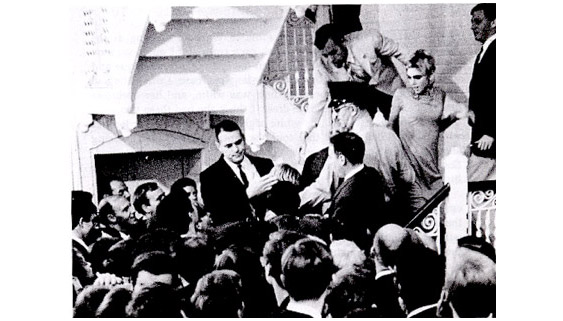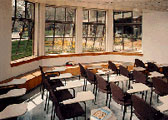"That Philadelphia exhibition of Andy's was one of the most bizarre mob scenes I've ever witnessed... It was the first survey of all his work... It was crazy. It was the first time I saw a young avant-garde artist have a show mobbed as if it were a movie premiere... all kinds of people clamoring to get at Andy as if he were a star." -- Walter Hopps
"Andy was mobbed. We were pretty scared because we arrived late from drinks and thousands were jammed into the museum. It was a mob scene and they were all out for blood. Somehow, once inside we managed to get to an old iron staircase that led up to the ceiling... an architectural student was trying to break through the fake ceiling above us so we could get out through the library private stacks, over the roof, and down the fire escape and out where the police could protect us... That's how we escaped." -- Sam Green

image: Edie Sedgwick (on stairs) and Andy Warhol (buried in crowd) try to get out of UPenn's Institute of Contemporary Arts (now the Fisher Fine Arts Library) alive. (1965)
In 1965, Andy Warhol had his first American museum exhibition at the Institute of Contemporary Art at the University of Pennsylvania. The place was so mobbed by students, fans, and the press that all of the paintings had to be removed from the walls because there was fear that they would be damaged. The crowd grew so large and unruly that Warhol and his entourage were forced to flee for fear of their lives.
This exhibition, arguably one of the most important of Warhol's career, marks a turning point in contemporary art, where the persona of the artist challenges the primacy of the works on display; by the time Warhol escaped, it was he whom the public wanted as much as the paintings he made.
The implications of this simple gesture are profound and play out in various ways over the next half-century, giving rise to performance and media art, as well as to the notion of the artist as celebrity as exemplified by Jeff Koons in the art world, Lady Gaga in music, and everybody's fifteen minutes of fame in reality television. We are all children of Warhol.
This year-long seminar, a collaboration between the Department of the History of Art and The Institute of Contemporary Art at the University of Pennsylvania, will focus on Warhol's 1965 ICA show. We'll research the circumstances surrounding the show: We'll look deeply into the life of Andy Warhol: What made him who he was? What cultural, social and political events led up to the show's powerful response? We'll explore the outcome of this show: What were the implications -- short and long term -- of his gesture? And, finally, we'll see that what happens to Warhol as a result of this show -- from assassination attempts to his rise as the world's most famous artist -- can be traced back to events that happened right here on the Penn campus.
By mining the deep archives of the ICA and the Penn libraries, we'll investigate this fascinating story by hunting down television broadcasts and vintage photographs; we'll dig up newspaper articles that were written for Penn student newspapers as well as in the mainstream press; we'll even speak to people who were there. We'll be archeologists, reconstructing the exhibition space by locating and mapping its original place, now buried in the basement of Fisher Fine Arts Library.
And what of the paintings themselves? Which paintings were they? How were they selected for the show? What happened to them after the show ended? Where do they fit into oeuvre of the artist? Where did they fit into the cultural landscape of their time, and how are they considered today?
We'll examine and deconstruct cultural artifacts, such as fashion: from the Rudi Gernreich dress that Edie Sedgwick was wearing to the Ray-Bans that Andy had on, no detail is too insignificant for consideration this rich semiotic ecosystem.
The culmination of the seminar will be an exhibition showcasing our research at the Institute of Contemporary Art.
This seminar offers a rare opportunity to do hands-on research into art historical events as well as real-world curatorial experience in a major cultural institution.
Permission is needed from the instructor. Please email a one-page summary of why you think you'd be an ideal candidate for inclusion. Enrollment is limited to 15.
ABOUT KENNETH GOLDSMITH
Kenneth Goldsmith's writing has been called "some of the most exhaustive and beautiful collage work yet produced in poetry" by Publishers Weekly. Goldsmith is the author of ten books of poetry, founding editor of the online archive UbuWeb (ubu.com), and the editor of I'll Be Your Mirror: The Selected Andy Warhol Interviews, which was the basis for an opera, "Trans-Warhol," that premiered in Geneva in March of 2007. Goldsmith also was a contributing editor to Andy Warhol Giant Size (Phaidon).
An hour-long documentary on his work, Sucking on Words premiered at the British Library in 2007. Kenneth Goldsmith is the host of a weekly radio show on New York City's WFMU. He teaches writing at The University of Pennsylvania, where he is a senior editor of PennSound, an online poetry archive. He is the The Anschutz Distinguished Fellow Professorship in American Studies at Princeton University for 2009-10 and received the Qwartz Electronic Music Award in Paris in 2009. A book of critical essays, Uncreative Writing, is forthcoming from Columbia University Press, as is an anthology from Northwestern University Press co-edited with Craig Dworkin, Against Expression: An Anthology of Conceptual Writing.
More about Goldsmith can be found at:
http://epc.buffalo.edu/authors/goldsmith/
http://en.wikipedia.org/wiki/Kenneth_Goldsmith









